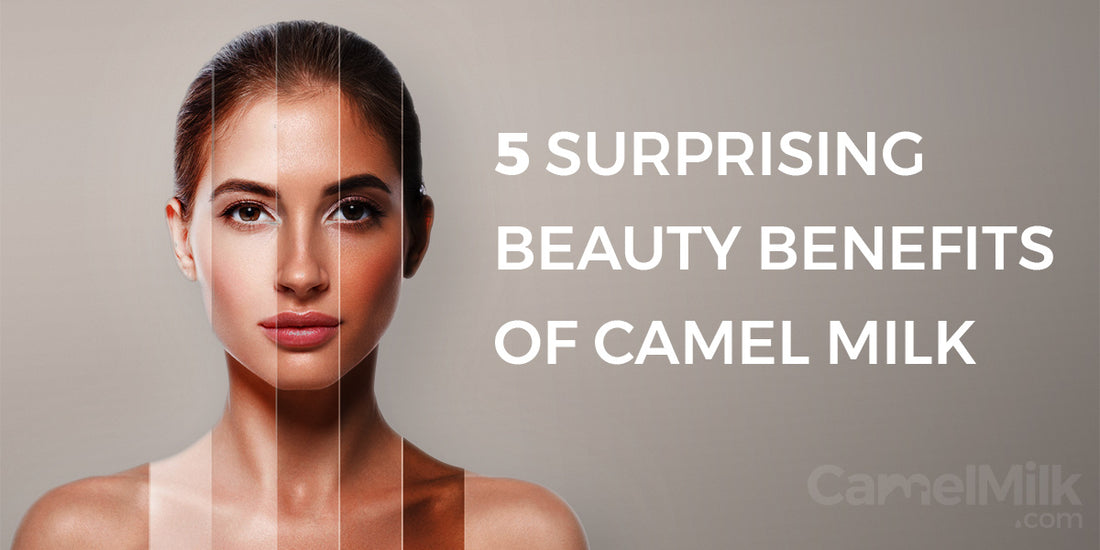If your skin is as dry as the Sahara Desert, the perfect natural remedy may be found in the desert itself. Deemed the “new thing in skincare” by several beauty blogs, camel milk is becoming known for its ability to improve the texture of skin, clear up acne and keep wrinkles away.
In addition to skin care, camel milk is also starting to make an appearance in shampoos, conditioners and body moisturizers. Let’s take a closer look at the health benefits of camel milk, and why it’s not only an ideal “all-in-one” alternative to the existing products in your beauty cabinet, but a food that can beautify from the inside out.
Camel Milk for Skin Brightening and Tightening
Camel milk — especially camel milk powder — contains two essential nutrients for plump and youthful skin: Vitamin C and elastin.
Vitamin C helps stimulate collagen production, the protein responsible for giving skin its soft, supple texture, while elastin maintains skin elasticity. Our bodies naturally produce collagen and elastin, but as we age, the amount we produce declines. This is when fine lines and wrinkles set in and skin begins to sag.
Rather than turning to expensive injections, we can increase our collagen and elastin production through dietary sources, such as camel milk. Applying camel milk powder topically as a face mask helps tighten the skin and exfoliate to remove dead skin cells, which instantly creates a brighter appearance. Camel milk absorbs best when combined with one or more ingredients, which is why you’ll find camel milk face masks formulated with natural clays, such as moroccan lava clay.
Healthy Hair and Nails
Shiny hair and strong nails are a sign that you’re receiving enough protein and healthy fats from your diet. While camel milk has the same amount of protein as cow milk, it’s higher in omega-3 essential fatty acids.
Healthy fats are needed to moisturize and nourish hair follicles from the inside out and strengthen nails. In fact, peeling nails are not uncommon for those who follow low fat diets, and is one of the first signs of omega 3 deficiency. If you can’t get your hair and nails to grow naturally, it may be time to up your omega-3 intake.
Since our bodies don’t produce omega-3 fatty acids, we must obtain them from food sources. In addition to drinking camel milk, chia, flaxseed, hemp hearts, wild salmon, and cod liver oil are all excellent sources of omega-3 fatty acids.
Anti-Aging Benefits of Camel Milk
We’ve briefly touched on vitamin C for collagen production, which helps preserve the appearance of skin. However, vitamin C is an antioxidant vitamin that can also help reduce oxidative stress, which damages cells and causes aging. Oxidative stress is caused by several factors such as environmental pollutants, smoking and secondhand smoke, toxins, excessive refined sugar and alcohol consumption, and trans-fats found in deep fried foods and processed foods.
Camel milk contains approximately three times the amount of vitamin C than cow milk, which makes it a better choice for promoting detoxification and healthier skin cells.
Moisturizing and Softening
As it turns out, Cleopatra was onto something with her daily ritual of bathing in camel milk. Camel milk helps soften the skin because it contains lanolin, a fatty acid known for locking in the skin’s natural moisture and soothing inflammation. In fact, many skin creams for chapped, cracked, and dry skin will list lanolin oil as one of the main ingredients.
Lanolin from natural food sources such as camel milk is safe for acne-prone skin, as it doesn’t have a high comedogenic rating (meaning it’s less likely to clog pores). Note: Lanolins are not to be confused with hydrogenated lanolins, which are man-made lanolins derived from alcohols. These synthetic lanolins are known to clog pores and irritate the skin, which can cause or worsen acne and redness.
Camel Milk for Clear Skin
Camel milk is rich in lactic acid — in addition to its antimicrobial and antibacterial properties, which can help kill acne-causing bacteria on the skin. Lactic acid is an alpha hydroxy acid that helps remove dead skin cells and germs from the skin, and reduces the severity and frequency of breakouts.
Lactic acid is one of the most common natural remedies recommended for acne-prone skin because it helps rebalance the skin’s pH, which can promote inflammation and the growth of bacteria when it becomes too alkaline. Studies show lactic acid can significantly lighten acne scars and hyperpigmentation on dark skin over extended periods of time when applied topically for at least three months. This suggests drinking camel milk may also have a similar effect on skin damage.
What Does Camel Milk Taste Like?
With a smooth texture and refreshing taste, camel milk makes the perfect superfood addition to your favorite recipes that call for milk, such as smoothies, waffles, and baking recipes—and let’s not forget, it’s great on it’s own, too.
Unlike cow milk, camel milk is extremely low in lactose, which makes it much easier to digest for those who are sensitive to dairy. Camel milk is also free from beta-lactoglobulin, which is one of the main proteins in cow milk that triggers an allergic reaction.
Choosing Camel Milk
As you can see, camel milk is a true beauty food based on the variety of healthy fats, antioxidants, and other anti-aging skin nutrients it contains. You can’t go wrong when it comes to using camel milk in your beauty routine, so it’s up to you to decide if you want to use it as a topical treatment or include it in your diet. For the most powerful results, we recommend doing both.

 Log in
Log in
